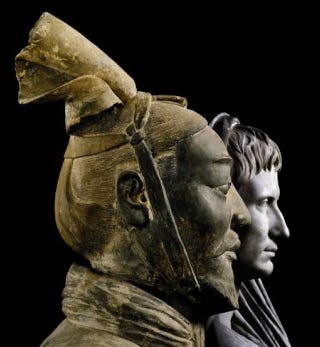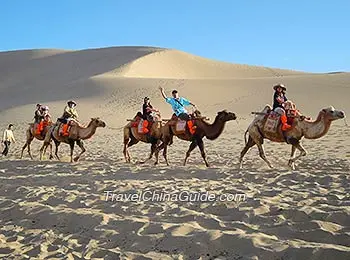
...
 .
.Originating at Xi’an (Sian), the 4,000-mile (6,400-km) road, actually a caravan tract, followed the Great Wall of China to the northwest, bypassed the Takla Makan Desert, climbed the Pamirs (mountains), crossed Afghanistan, and went on to the Levant; from there the merchandise was shipped across the Mediterranean Sea. Few persons traveled the entire route, and goods were handled in a staggered progression by middlemen.
(the Roman Empire) has more than four hundred smaller cities and towns. It extends several thousand li in all directions. The king has his capital (that is, the city of Rome) close to the mouth of a river (the Tiber). The outer walls of the city are made of stone
The kingdom of Da Qin (Rome) is also called Lijian. It is west of Anxi (Parthia) and Tiaozhi (Characene and Susiana), and west of the Great Sea
From the city of Angu (Gerrha), on the frontier of Anxi (Parthia), you take a boat and cut directly across to Haixi (‘West of the Sea’ = Egypt). With favourable winds it takes two months; if the winds are slow, perhaps a year; if there is no wind, perhaps three years.
The country (that you reach) is west of the sea (haixi), which is why it is called Haixi (literally: ‘West of the Sea’ = Egypt). There is a river (the Nile) flowing out of the west of this country, and then there is another great sea (the Mediterranean). The city of (Wu) Chisan (Alexandria) is in Haixi (Egypt).

Now, if you leave the city of Angu (Gerrha) by the overland route, you go north to Haibei (‘North of the Sea’ – the lands between Babylonia and Jordan), then west to Haixi (Egypt), then turn south to go through the city of Wuchisan (Alexandria). After crossing a river, which takes a day by boat, you circle around the coast (to the region of Apollonia, the port of Cyrene). (From there, i.e. the region of Apollonia) six days is generally enough to cross the (second) great sea (the Mediterranean) to reach that country (Da Qin = Rome)
The economy in the Roman world displayed features of both underdevelopment and high achievement. Elements of the former, some historians have argued (notably M.I.Finley), are an over-dependence on agriculture, a slow diffusion of technology, the high level of local town consumption rather than regional trade, and a low level of investment in industry. However, there is also evidence that from the 2nd century BCE to the 2nd century CE there was a significant rise in the proportion of workers involved in the production and services industries and greater trade between regions in essential commodities and manufactured goods. In the later empire period, although trade in the east increased - stimulated by the founding of Constantinople - trade in the western empire declined.
Trade involved foodstuffs (e.g. olives, fish, meat, cereals, salt, prepared foods such as fish sauce, olive oil, wine and beer), animal products (e.g. leather and hides), objects made from wood, glass, or metals, textiles, pottery, and materials for manufacturing and construction such as glass, marble, wood, wool, bricks, gold, silver, copper, and tin. Finally, there was, of course, also the substantial trade in slaves.

After Alexander the Great conquered the Persians, he established the city of Alexandria Eschate in 339 BCE in the Fergana Valley of Neb (modern Tajikstan). Leaving behind his wounded veterans in the city, Alexander moved on. In time, these Macedonian warriors intermarried with the indigenous populace creating the Greco-Bactrian culture which flourished under the Seleucid Empire following Alexander’s death. Under the Greco-Bactrian king Euthydemus I (260-195 BCE) the Greco-Bactrians had extended their holdings. According to the Greek historian Strabo (63-24 CE) the Greeks “extended their empire as far as the Seres” (xi.ii.i). `Seres’ was the name by which the Greeks and Romans knew China, meaning `the land where silk came from’. It is thought, then, that the first contact between China and the west came around the year 200 BCE
While many different kinds of merchandise traveled along the Silk Road, the name comes from the popularity of Chinese silk with the west, especially with Rome. The Silk Road routes stretched from China through India, Asia Minor, up throughout Mesopotamia, to Egypt, the African continent, Greece, Rome, and Britain. The northern Mesopotamian region (present day Iran) became China’s closest partner in trade, as part of the Parthian Empire, initiating important cultural exchanges. Paper, which had been invented by the Chinese during the Han Dynasty, and gunpowder, also a Chinese invention, had a much greater impact on culture than did silk. The rich spices of the east, also, contributed more than the fashion which grew up from the silk industry. Even so, by the time of the Roman Emperor Augustus (27 BCE – 14 CE) trade between China and the west was firmly established and silk was the most sought after commodity in Egypt, Greece, and, especially, in Rome.
Alexander (Greek: Alexandros) mentions that the main terminus for Roman traders was a Burmese city called Tamala on the north-west Malay Peninsula, where Indian merchants travelled overland across the Kra Isthmus to reach the Perimulic Gulf (the Gulf of Thailand).[15] Alexandros claimed that it took twenty days to sail from Thailand to a port called "Zabia" (or Zaba) in southern Vietnam.[

At some point during the 1st century BC, silk was introduced to the Roman Empire, where it was considered an exotic luxury and became extremely popular, with imperial edicts being issued to control prices. Its popularity continued throughout the Middle Ages, with detailed Byzantine regulations for the manufacture of silk clothes, illustrating its importance as a quintessentially royal fabric and an important source of revenue for the crown. Additionally, the needs of the Byzantine Church for silk garments and hangings were substantial. This luxury item was thus one of the early impetuses in the development of trading routes from Europe to the Far East.

the silk trade was one of the earliest catalysts for the trade routes across Central Asia, it was only one of a wide range of products that was traded between east and west, and which included textiles, spices, grain, vegetables and fruit, animal hides, tools, wood work, metal work, religious objects, art work, precious stones and much more. Indeed, the Silk Roads became more popular and increasingly well-travelled over the course of the Middle Ages, and were still in use in the 19th century, a testimony not only to their usefulness but also to their flexibility and adaptability to the changing demands of society. Nor did these trading paths follow only one trail – merchants had a wide choice of different routes crossing a variety of regions of Eastern Europe, the Middle East, Central Asia and the Far East, as well as the maritime routes, which transported goods from China and South East Asia through the Indian Ocean to Africa, India and the Near East.
...
...................
No comments:
Post a Comment